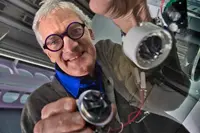Electronics News
Archive : 16 March 2015 год
 Dyson is investing $15million in University of Michigan spin off Sakti3. The partnership with Sakti3 – a developer of solid state battery technology – is part of Dyson's plans to introduce 100 new machines in four new portfolios of technology over the next four years.
Dyson is investing $15million in University of Michigan spin off Sakti3. The partnership with Sakti3 – a developer of solid state battery technology – is part of Dyson's plans to introduce 100 new machines in four new portfolios of technology over the next four years.
Dyson is investing $15million in University of Michigan spin off Sakti3. The partnership with Sakti3 – a developer of solid state battery technology – is part of Dyson's plans to introduce 100 new machines in four new portfolios of technology over the next four years.
James Dyson, pictured, said: "Sakti3 has achieved leaps in performance which current battery technology simply can't. It's these fundamental technologies – batteries, motors – that allow machines to work properly. The Sakti3 team has amazing ambitions, and their platform offers the potential for exponential performance gains that will supercharge the Dyson machines we know today."
Since 2006, Sakti3 has built and commissioned a pilot line to produce its technology, raising more than $50m from a range of sources. The company has developed prototype solid state battery cells with energy densities of more than 1100Whr/l – said to be twice the density of the most advanced liquid lithium ion batteries.
Ann Marie Sastry, Sakti3's CEO, said: "It was quite an honour for us to be approached by Dyson, precisely because it wanted what we did – much, much better batteries. There is a great deal of knowledge and passion on both sides and Dyson's engineering team has the capability and the track record to scale up new ideas and make them a commercial reality. Together, we will enable some very transformative products."
Author
Graham Pitcher
Source: www.newelectronics.co.uk
 Engineering researchers from Columbia University in the US have devised a way to implement full duplex radio ICs in nanoscale CMOS. The devices are said to support simultaneous transmission and reception at the same frequency; something previously thought to be impossible. The presented its work at the recent ISSCC event in San Francisco.
Engineering researchers from Columbia University in the US have devised a way to implement full duplex radio ICs in nanoscale CMOS. The devices are said to support simultaneous transmission and reception at the same frequency; something previously thought to be impossible. The presented its work at the recent ISSCC event in San Francisco.
Engineering researchers from Columbia University in the US have devised a way to implement full duplex radio ICs in nanoscale CMOS. The devices are said to support simultaneous transmission and reception at the same frequency; something previously thought to be impossible. The presented its work at the recent ISSCC event in San Francisco.
"This is a game changer," claimed Associate Professor Harish Krishnaswamy. "By leveraging our new technology, networks can effectively double the frequency spectrum resources available for devices like smartphones and tablets."
With data communications facing a capacity crunch, the ability to transmit and receive at the same frequency could double network capacity. Prof Krishnaswamy noted that other research groups and companies have demonstrated the theoretical feasibility of simultaneous transmission and reception at the same frequency, but no one has built chips with this capability.
"Our work is the first to demonstrate an IC that can receive and transmit simultaneously," he claimed. "Doing this in an IC is critical if we are to have widespread impact and bring this functionality to handheld devices and in cellular and WiFi base stations to support full duplex communications."
The team now plans to test a number of full duplex nodes to understand gains at the network level. "We are working closely with Electrical Engineering Associate Professor Gil Zussman's group, who are network theory experts at Columbia Engineering. It will be very exciting if we are indeed able to deliver the promised performance gains," he concluded.
Author
Graham Pitcher
Source: www.newelectronics.co.uk
 Electroplating Engineers of Japan and the University of Tokyo claim to developed an electroless plating process which enables the simultaneous formation of contact electrodes for p-type and n-type organic field effect transistors (OFET).
Electroplating Engineers of Japan and the University of Tokyo claim to developed an electroless plating process which enables the simultaneous formation of contact electrodes for p-type and n-type organic field effect transistors (OFET).
The process, which uses silver nanoparticles as a catalyst, allows the formation of top contact OFET contact electrodes without the need for a vacuum. According to the partners, more advanced organic electronic devices can now be formed at a lower cost.
For p-type organic semiconductors, the contact resistance is said to be 0.1kO-cm or less – the lowest value yet achieved without a vacuum.
This technology enables the creation of contact electrodes with a gold-silver hybrid structure. It starts with the application of a silver catalyst solution, after which a gold coating is applied to the substrate by immersing it in an electroless gold plating solution, filling the gaps between the silver grains with gold.
The collaborators acknowledge there are other methods for the formation of OFET contact electrodes, but claims these suffer from such issues as requiring a vacuum environment or can damage the organic semiconductors.
They say thin film electrodes can be formed uniformly using vacuum deposition, but this approach is expensive and the loss of materials is 'huge'. Also, while electrode formation in the atmosphere is possible using metallic ink and metallic paste, this requires the inclusion of organic solvents, high temperature sintering and hardening by means of ultra violet radiation, which can also damage the organic semiconductor.
Author
Graham Pitcher
Source: www.newelectronics.co.uk

